Thursday, 11 May 2023 00:10 – – 19
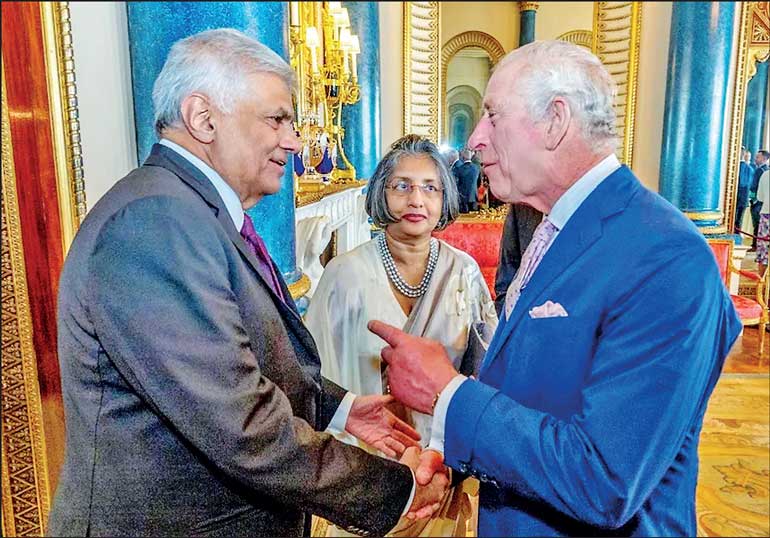 Ranil, Champion of the Right
Ranil, Champion of the Right
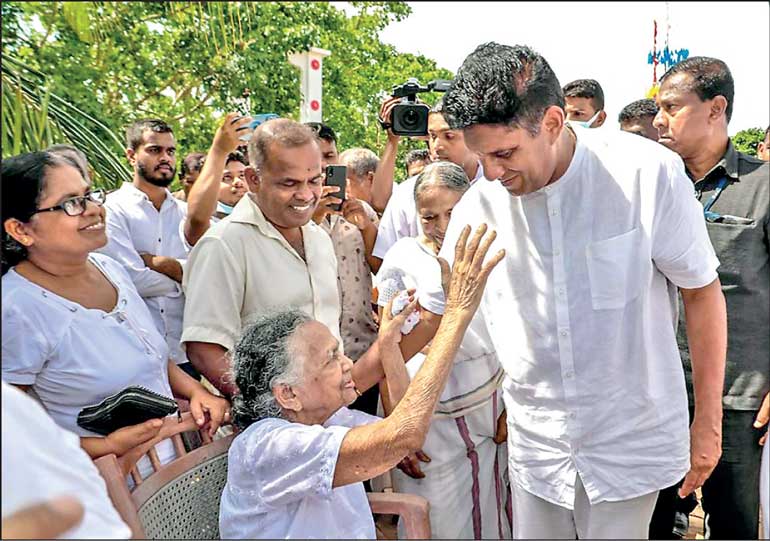
Sajith: Centrist Targeted
 Can the incipient Opposition in-gathering reverse the ideological polarisation underway, which accompanies the uneven socioeconomic polarisation on the ground?
Can the incipient Opposition in-gathering reverse the ideological polarisation underway, which accompanies the uneven socioeconomic polarisation on the ground?
In his May Day speech this year, JVP leader Anura Kumara Dissanayake declared that there were “only two camps” in Sri Lankan politics. On the one hand, there is the camp of the Right consisting of the entire establishment that ruled Sri Lanka for 75 years and ruined it—an establishment which includes the SJB as evidenced by its facilitation of the parliamentary passage of the Government’s IMF deal. On the other hand, stands the NPP. The Rightwing camp is in decline and is therefore turning viciously authoritarian while the NPP camp is in the ascendancy among the masses, he concluded.
Can the new Opposition convergence headed by Sajith Premadasa and bringing together the SJB, the FPC, other dissidents of the SLPP and the ethnic minority parties, counter this polarisation and disprove AKD’s dangerously Manichean Cold War era ‘two-camp theory’?
Yes, but only if it represents a broadly social democratic progressive alternative which regards the rightwing incumbent, regime and policies as a cluster constituting the main adversary and target.
Polarisation
One of the most dangerous afflictions that could befall a democratic political order is affecting Sri Lanka: the erosion and disappearance of the political and ideological centre-space. The politico-ideological centre is the imperative structural space that imparts balance, moderation and a possibility of equilibrium to a system, without which stability and the political order itself are doomed.
That vital centre is vanishing before our eyes, or worse, under our feet. Without it, society will be torn apart. The centre holds everything together. The politico-ideological centre represents the philosophical Middle Path or Golden Mean. Without it, the process of polarisation accelerates, extreme poles alone compete and ‘things fall apart’.
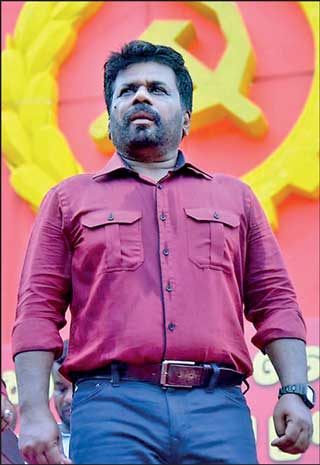 |
| The Challenger on May Day 2023 |
Some might argue that the erosion of the centre is an inevitable aspect of a deep crisis. To the contrary, Sri Lanka has been through race riots, suicide bombings, assassinations and three civil wars while retaining its vital politico-ideological centre; its middle ground. Paradoxically, today, in the face of a non-violent crisis, it is in danger of losing that most valuable of political real-estate.
The centre-space is being polarised primarily but not exclusively because of discourse and policies of President Wickremesinghe, the Prince of Polarisation in Sri Lankan politics. The SJB and JVP-NPP have also begun to abandon the centre-space ideologically, with the former containing an element openly supporting and colluding with Ranil’s ultra-right economic agenda and the latter drawing further to the left, instead of winning and occupying the middle-ground.
More Mangala than Premadasa
When the SJB was formed, Mangala Samaraweera resigned shortly after on the grounds that under Sajith’s leadership it was becoming ‘MR Lite’. My counterargument at the time was that even if that were true, being perceived as ‘MR Lite’ was electorally preferable to being perceived as ‘Ranil Lite’, because the vast reservoir of Sinhala votes that had to be won over/won back could only be attracted by a populist centrism which was preponderantly (Ranasinghe) Premadasa-ist, albeit with ‘MR Lite’ as an added ingredient. My point has been proven correct three years on by Dr. Ravi Ranan-Eliya’s IHP/SLOTS tracker which consistently confirms that Anura Kumara Dissanayake’s JVP-NPP has drawn ahead of the SJB because it has succeeded, unlike the SJB, in drawing to its side the overwhelming majority of discontented Pohottuwa voters.
Starting out, the SJB correctly had two explicit reference points: Ranasinghe Premadasa’s Citizens’ Front (‘Puravesi Peramuna’) of 1972-3 and SWRD’s early (pre-‘Sinhala Only’) SLFP, formed in 1951. Sajith Premadasa defined the party’s ideology as ‘social democratic’, which he reiterates to this day. The SJB was perfectly poised to do what SWRD and the SLFP did: carve out a middle path, displacing the powerful Marxist Left as the main alternative to the conservative, elitist Establishment party the UNP, by drawing support from Left and Right through an essentially populist ideological fusion.
How then is Mangala Samaraweera’s ideological and strategic directional preference prevailing over that of Ranasinghe Premadasa’s project in a party led by the late President’s son? Why is the island’s political centre and ideological middle-ground shrinking dangerously due to an undercurrent which is taking the SJB away from the progressive populist centre, to the neoliberal right in economics?
There was a deviation from the original decision to carve out a new, non-UNP space which absorbed the UNP but transcended it by a ‘multi-vector’ policy of break-out and break-through in all directions. That decision was substituted by an effort to become the next/new UNP; to fill the UNP ideological-programmatic space and dwell within that constricted comfort-zone, repositioning itself as the centre-right party.
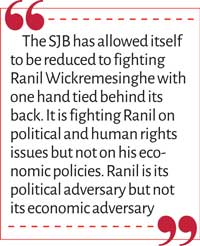 The SJB leader holds the sole franchise of the Premadasa political economy which the UNP abandoned 30 years ago. That is the perfect alternative to neoliberal Ranilnomics as well as the JVP’s untested, unimpressive and risky economic policy platform. And yet, the SJB is not basing itself on Premadasa developmental populism. Instead, its official policy document the Economic Blueprint, does not lend itself as a weapon against the incumbent’s economics, so congruent and overlapping are the two. The contradictions between Ranil’s economic policy doctrine and framework and the currently available document of the main Opposition party are not those between two competing economic doctrines, models or strategies.
The SJB leader holds the sole franchise of the Premadasa political economy which the UNP abandoned 30 years ago. That is the perfect alternative to neoliberal Ranilnomics as well as the JVP’s untested, unimpressive and risky economic policy platform. And yet, the SJB is not basing itself on Premadasa developmental populism. Instead, its official policy document the Economic Blueprint, does not lend itself as a weapon against the incumbent’s economics, so congruent and overlapping are the two. The contradictions between Ranil’s economic policy doctrine and framework and the currently available document of the main Opposition party are not those between two competing economic doctrines, models or strategies.
So long as Ranil’s proteges in the SJB keep the main Opposition party within the same economic-ideological orbit as the UNP and the Pohottuwa’s young Ministerial converts to economic Ranilism, the SJB is caught in a clinch, and cannot effectively challenge and combat the incumbent. You can’t fight the ‘Republican’ Right from the Centre-Right; you can only do so from the progressive Centre (Obama, Biden), the Centre-Left (Ardern, Albanese) or the Left (Lula, AMLO).
The new Opposition convergence must represent the progressive centre, positioned in the broad global space occupied by the US Democrats, UK Labour, Europe’s Social Democrats and Latin America’s ‘Pink Left’.
SJB’s self-sabotage
The SJB has allowed itself to be reduced to fighting Ranil Wickremesinghe with one hand tied behind its back. It is fighting Ranil on political and human rights issues but not on his economic policies. Ranil is its political adversary but not its economic adversary.
The SJB is behaving as if their main enemy is either the JVP-NPP (whom they absurdly identify with North Korea in policy terms) or the Rajapaksa-led Pohottuwa. The latter would have been a rational choice as prime target had a Rajapaksa been the incumbent or a serious contender at a presidential election, but that is manifestly not the case. The Rajapaksas should be targeted but as the Ranil-Rajapaksa axis, and that too, not as the only negative factor in the hybrid regime.
As for the JVP-NPP, it should certainly be considered the SJB’s main target IF and ONLY IF we had a President who was not running. But when one has an incumbent running for office – it is usually re-election, but Ranil’s case is an exception—that incumbent is the main foe of any serious Opposition candidate. Intra-Opposition rivalry is relegated to second place. This is especially so when the incumbent is driving through a harsh austerity program.
The SJB is not a human rights NGO, admirable as they are. It is a political party running for the Presidency next year in a context in which mass privation is rising. Poverty has doubled in a year according to the World Bank, a third of Sri Lankans are malnourished, living in food insecurity. That wasn’t on the JVP-NPP’s watch. The numbers of poor entitled to state support are being savagely culled, and that’s not by the JVP-NPP. (World Bank and IMF’s targeted discourse against working poor of Sri Lanka | Daily FT) The voters won’t hold their rapid povertisation against the JVP-NPP. They’ll punish the incumbent, anyone closely associated with his economics (during the Bond scam, Hambantota give-away and above all the ISB haemorrhage), and anyone hasn’t sufficiently differentiated from him and looks to be a substitute/extension.
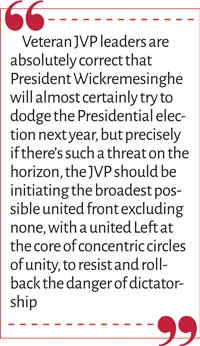 In the year before the Presidential election, the SJB has failed to grasp that it is precisely the visibility, efficacy and appeal of its contestation of the incumbent and resistance to his policies that will position it ahead of or behind its rival the JVP-NPP.
In the year before the Presidential election, the SJB has failed to grasp that it is precisely the visibility, efficacy and appeal of its contestation of the incumbent and resistance to his policies that will position it ahead of or behind its rival the JVP-NPP.
What registers on the mass mind is the actual voting in parliament, not rhetoric outside it. Absenteeism is not abstention. Abstention signals non-alignment, sometimes, neutrality, and infrequently equidistance. India and over 30 countries representing the majority of the world’s populace abstain at UN votes on the Ukraine war. Abstentions are recorded as part of the vote; absentees are not. Absenteeism is the goalie taking a smoking break while the opponent is kicking the ball into the goal.
During the IMF vote, the SJB had the option of abstention, but was abruptly absent instead. If the SJB remains purely political, not economic, in its critique of and resistance to Ranil, it would incapacitate itself before it climbs into the ring with the incumbent next year. What if Ranasinghe Premadasa ‘hedged’ on the IPKF issue in 1988 when rival candidate Sirimavo Bandaranaike, and the JVP, were pledging to send it away?
Ranil’s pincer-moves
Though President Wickremesinghe’s stated aim is the solution or settlement of the longstanding ethnonational issue, that cannot be achieved in the double context of a harsh economic program and an unelected incumbency. Global data shows that a period of harsh austerity is the worst time to move on ethnic reform because people tend to express, and governments tend to divert, socioeconomic hurt through ethnoreligious channels. In Sri Lanka today, the SLPP shield will not block an ethno-regional majoritarian backlash.
The only way to work out a settlement of the ethnic problem is through a freshly elected local authorities, Provincial Councils, Parliament and a Presidency. But that’s not Ranil’s roadmap.
He has already used the argument of a new electoral system to postpone the local authorities election. He will almost certainly use the broader argument of ‘settling the longstanding ethnic issue’ to initiate a process of a new Constitution or at least its drastic reform, which can furnish the chance for prolonged incumbency. This was a tactic that Madam Bandaranaike used in 1972 to stay in office two years longer than the term she was elected for, and President Chandrika attempted with her ‘transitional provisions’ addendum to the August 2000 draft Constitution. If Ranil and/or the SJB Right succeed in drawing that party into a bloc of the Right, the incumbent gets his hands on the nuclear button: a two-thirds majority to postpone Presidential elections on the grounds of completing the IMF reform agenda and ‘solving’ the ethnic problem through a new Constitution.
Ranil is operating a two-pronged strategy—economic and ethnic—in a pincer move to encircle and ensnare the SJB. The main Opposition party should counter by imposing as the non-negotiable condition, fresh elections at all levels. If instead, the SJB pulls its punches on the economy and unconditionally collaborates on ethnic-constitutional reform, sacrificing overarching island-wide issues of democracy, it would leave the JVP-NPP the only real option for resistance available to the discontented masses, dangerously unbalancing and capsizing the system.
Red, not pink left
If the permission granted to the JVP-NPP to hold its May Day on Colombo’s Town Hall grounds is a conspiracy, it must be recalled that the first time Rohana Wijeweera was allowed to address a mammoth May Day crowd at the Town Hall grounds, the greenlight was came from Prime Minister and Minister of Local Government R. Premadasa after prolonged conversation with Wijeweera and Kelly Senanayake who had called on him.
The JVP’s May Day showing this year was a strategically significant landmark, not just because of the impressive size and spirit of the crowd. It was the strategic-existential choice the JVP made in this pre-election year, NOT to be a ‘Pink Left’ as is the Latin American, but to remain a ‘Red’ Left and even spray a fresh coat of red paint, parading its retro-chic logo and iconography and reasserting its ideological brand.
The arrogant abortion by President Wickremesinghe of the local government election deferred the JVP-NPP’s hopes, reinfused bitterness and weakened the dynamic of its transformation into a moderate democratic Left.
Senior party personalities like Tilvin Silva (JVP General-Secretary) and KD Lal Kantha clearly warned that Ranil Wickremesinghe doesn’t intend to hold presidential elections next year, and therefore the movement must develop the organizational sinew to pre-emptively deprive Ranil of the postponement option and wrest that election by means of a ‘people’s Aragalaya’ led by the ‘organized working class’. That apparently required a reconfiguration which includes the retention of the old apparatus of symbolism and anti-capitalist messaging. In contradistinction, Anura Dissanayake seems to view the electoral option as Plan A and mass struggle as Plan B. “There will be a presidential election next year, and until then the enemy shall not succeed in drawing us into premature confrontations”.
It is the difference between the pessimism (or realism) of the elders and the optimism (or pragmatism) of the younger man. What is needed however, is strategic sagacity.
Parties with a mature Marxist-Leninist formation do not make strategy on the basis of inner-party dynamics and compulsive reactions to regime provocation. Movements far more militantly Marxist-Leninist in their provenance, and with a much more successful military past, such as El Salvador’s FMLN have studiedly deleted their ideological symbolism and imagery, including those of founder-leaders. This is because, quite unlike the JVP, such movements had successful experience in complex strategic thinking and decision-making. Consequently, the FMLN was elected to the presidency more than once, with Salvador Sanchez Ceren (aka Leonel Gonzalez) the guerrilla comandante who headed the most militantly Leninist politico-military vanguard organization in Latin America, El Salvador’s FPL (succeeding its founder, Cayetano Carpio who committed suicide), winning the Presidency.
The FMLN knew that its civil war record guaranteed it an irreducible mass base in many zones, which did not need the old symbolism to be retained. It also knew that parading that old symbolism would rekindle not only old hatreds but also old and new apprehensions among the voters who needed to be won over. So, the old iconography and memorabilia were phased-out.
We see exactly the same phenomenon in the case of the legendary ex-urban guerrilla movement with a revolutionary socialist background, the Tupamaros-MLN, which won Uruguay’s presidency twice (‘Pepe’ Mujica was their iconic president). You hardly see images or hear mentions of the Tupas’ heroic founder-leader Raul Sendic.
To its (and the country’s) detriment, the JVP is none of these parties/types. Veteran JVP leaders are absolutely correct that President Wickremesinghe will almost certainly try to dodge the Presidential election next year, but precisely if there’s such a threat on the horizon, the JVP should be initiating the broadest possible united front excluding none, with a united Left at the core of concentric circles of unity, to resist and roll-back the danger of dictatorship.


